1994 CHEVROLET CAVALIER steering
[x] Cancel search: steeringPage 162 of 243
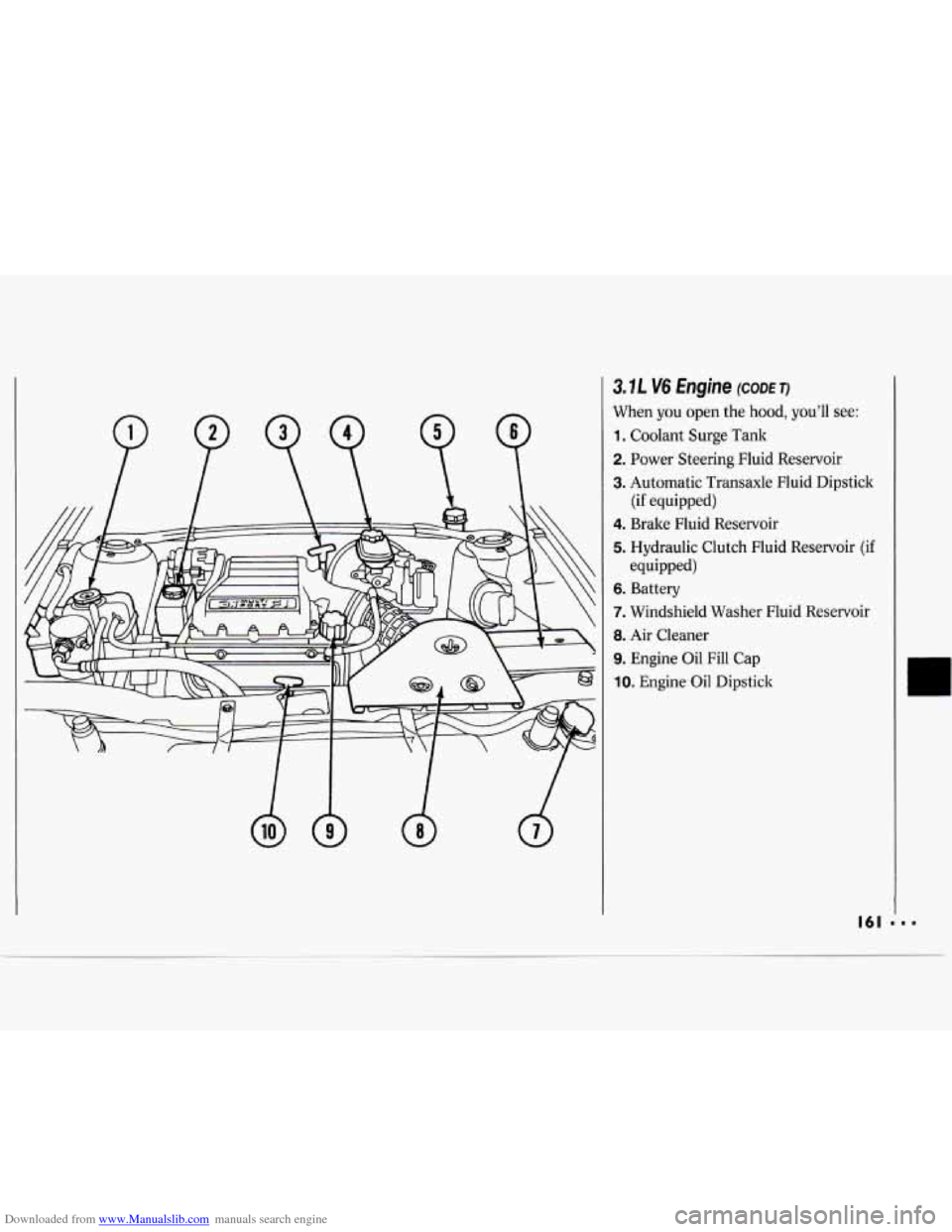
Downloaded from www.Manualslib.com manuals search engine 3.7L V6 Engine (CODE TI
When you open the hood, you’ll see:
1. Coolant Surge Tank
2. Power Steering Fluid Reservoir
3. Automatic Transaxle Fluid Dipstick
4. Brake Fluid Reservoir
5. Hydraulic Clutch Fluid Reservoir (if
6. Battery
7. Windshield Washer Fluid Reservoir
8. Air Cleaner
9. Engine Oil Fill Cap
IO. Engine Oil Dipstick
(if equipped)
equipped)
Page 174 of 243
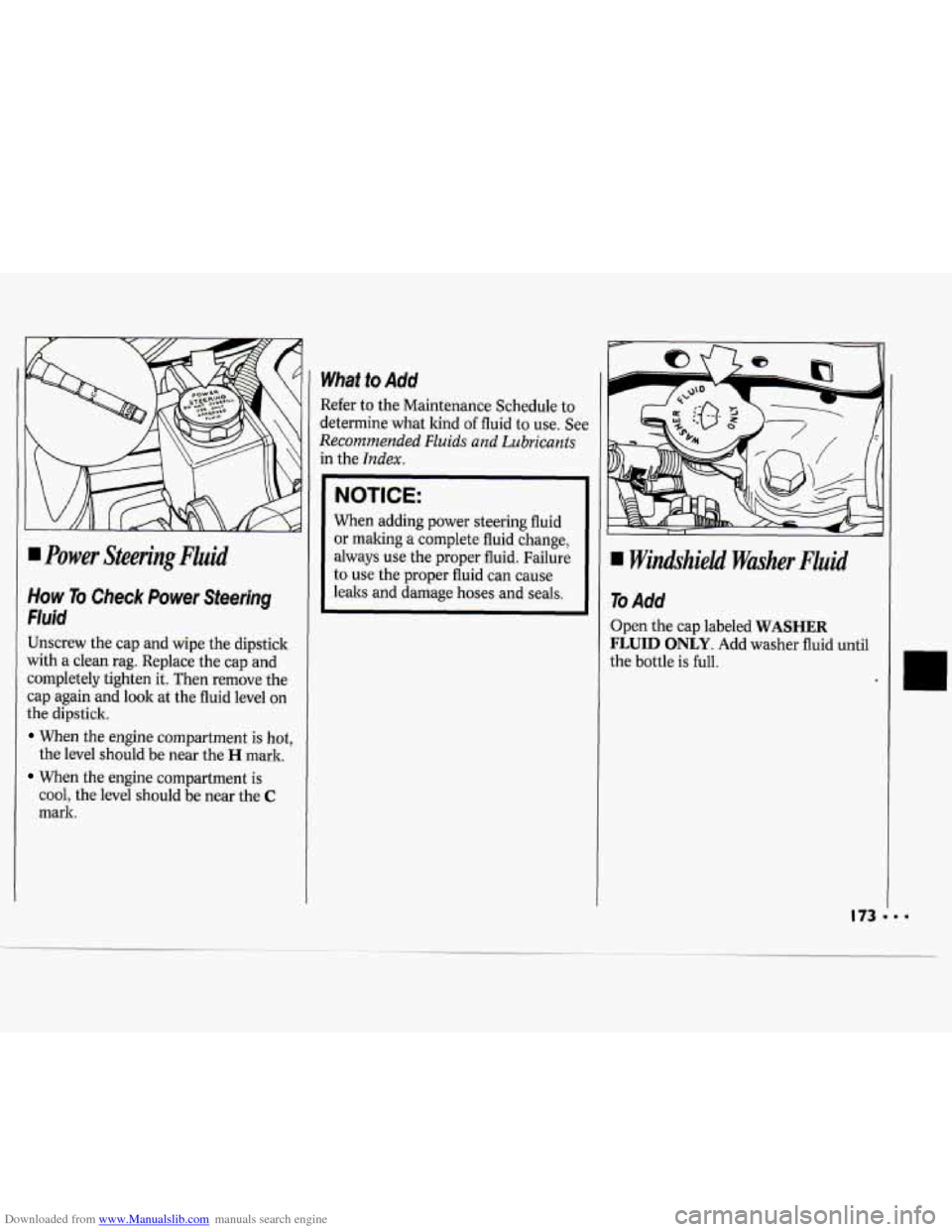
Downloaded from www.Manualslib.com manuals search engine I Power Steering Fluid
How To Check Power Steering
Fluid
Unscrew the cap and wipe the dipstick
with a clean rag. Replace the cap and
completely tighten it. Then remove the
cap again and look at the fluid level on
the dipstick.
When the engine compartment is hot,
the level should be near the
H mark.
When the engine compartment is
cool, the level should be near the
C
mark.
What to Add
Refer to the Maintenance Schedule to
determine what kind of fluid to use. See
Recommended Fluids and Lubricants
in the Index.
NOTICE:
When adding power steering fluid
or malting
a complete fluid change,
always use the proper fluid. Failure
to use the proper fluid can cause
leaks and damage hoses and seals. I Windshield Washer Fluid
ro AM
Open the cap labeled WASHER
FLUID
ONLY. Add washer fluid until
the bottle is full.
Page 199 of 243
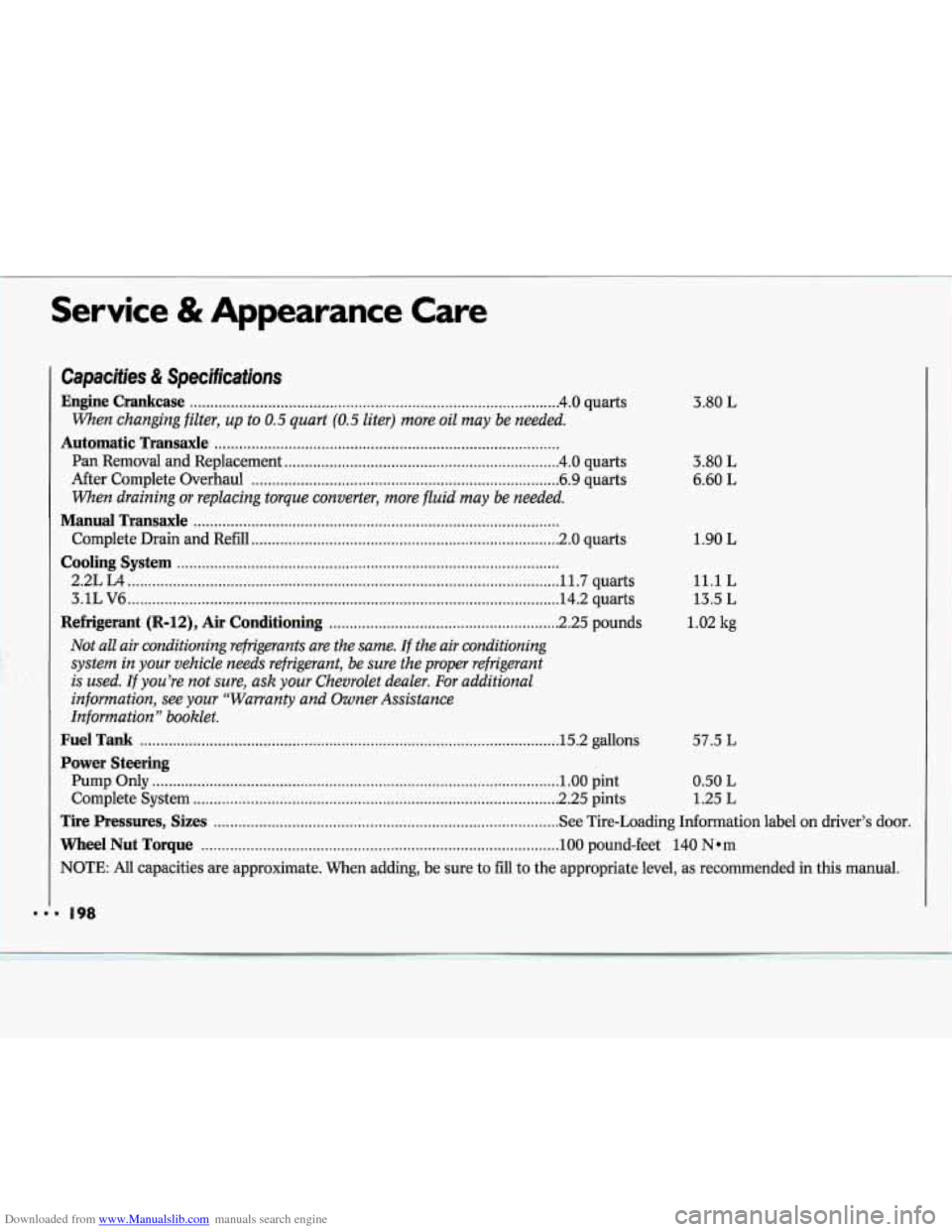
Downloaded from www.Manualslib.com manuals search engine Service & Appearance Care
Capacities & Specifications
Engine Crankcase ........................................................................\
.................. 4.0 quarts
When changing filter, up to 0.5 quart (0.5 liter) more oil may be needed.
Automatic Transaxle ........................................................................\
............
Pan Removal and Replacement ................................................................... 4.0 quarts
After Complete Overhaul
........................................................................\
... 6.9 quarts
When draining or replacing torque converter, more fluid may be needed.
Manual Transaxle ........................................................................\
.................
Complete Drain and Refill ........................................................................\
... 2.0 quarts
Cooling System ........................................................................\
.....................
2.2L L4 ........................................................................\
................................. 11.7 quarts
3.1L V6
........................................................................\
................................. 14.2 quarts
Refrigerant (R-12), Air Conditioning ........................................................ 2.25 pounds
Not all air conditioning refrigerants are the same. If the air conditioning
system in your vehicle needs refrigerant, be sure the proper refrigerant
is used. If you’re not sure, ask your Chevrolet dealer. For additional
information, see
your “Warranty and Owner Assistance
Information
” booklet.
Fuel Tank ........................................................................\
............................. .15.2 gallons
Power Steering
Pump Only ........................................................................\
........................... 1.00 pint
Complete System
........................................................................\
................. 2.25 pints 3.80
L
3.80
L
6.60 L
1.90
L
11.1 L
13.5 L
1.02 kg
57.5 L
0.50 L
1.25 L
Tire Pressures, Sizes ........................................................................\
............ See Tire-Loading Information label on driver’s door.
Wheel Nut Torque ........................................................................\
............... 100 pound-feet 140 Nom
NOTE: All capacities are approximate. When adding, be sure to fill to the appropriate level, as recommended in this manual.
Page 200 of 243
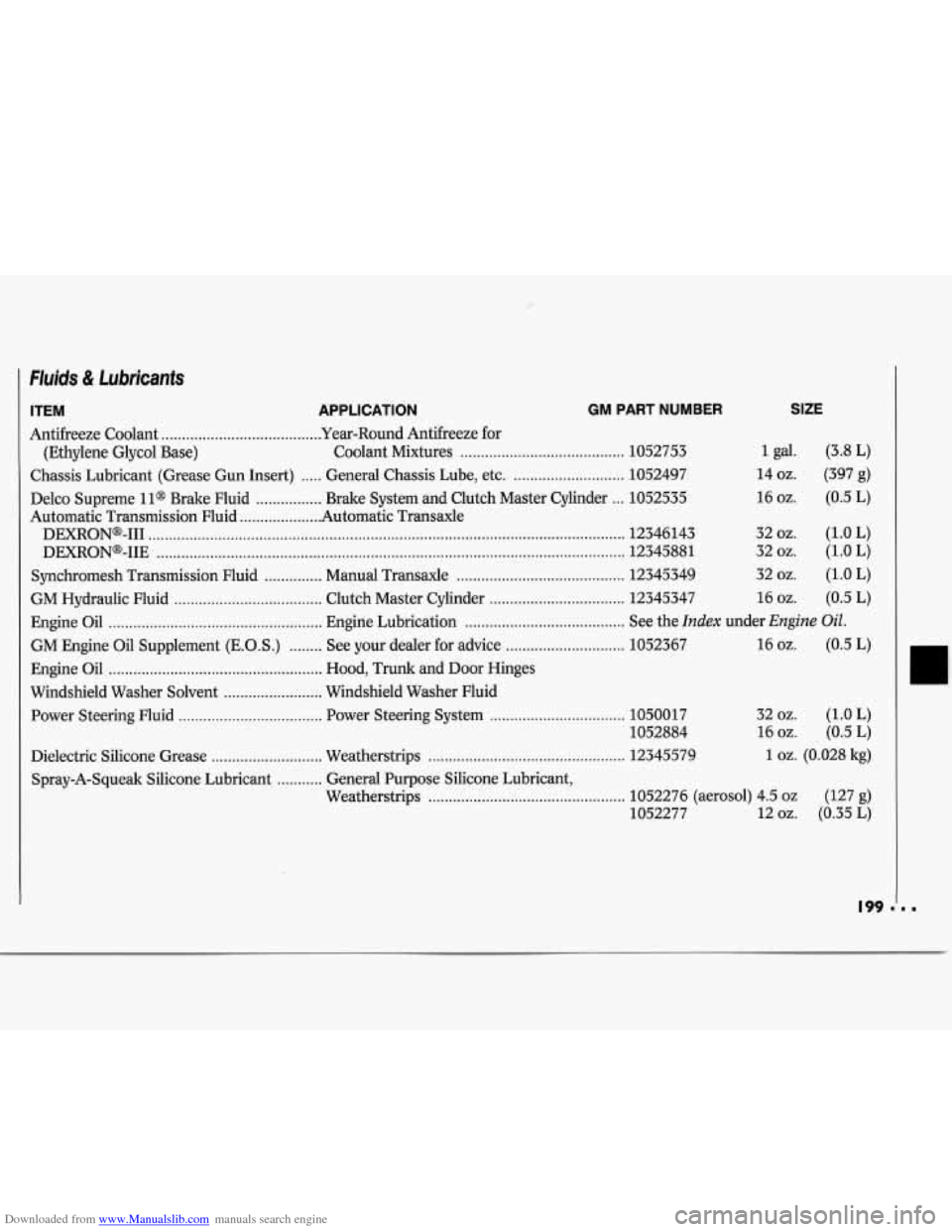
Downloaded from www.Manualslib.com manuals search engine ,
Fluids & Lubricants
ITEM APPLICATION GM PART NUMBER
Antifreeze Coolant ...................................... .Year-Round Antifreeze for
(Ethylene Glycol Base) Coolant Mixtures
........................................ 1052753
Chassis Lubricant (Grease Gun Insert)
..... General Chassis Lube, etc. ........................... 1052497
Delco Supreme
1 l@ Brake Fluid ................ Brake System and Clutch Master Cylinder ... 1052535
Automatic Transmission Fluid
.................... Automatic Transaxle
DEXRON@-I11
........................................................................\
............................................ 12346143
DEXRONa-IIE
........................................................................\
.......................................... 12345881
Synchromesh Transmission Fluid
.............. Manual Transaxle ......................................... 12345349
GM Hydraulic Fluid
.................................... Clutch Master Cylinder ................................. 12345347
SIZE
1 gal.
14 oz.
16 oz.
32 oz.
32 oz.
32 oz.
16 oz. (3.8 L)
(397
8)
(0.5 L)
(1.0
L)
(1.0 L)
(1.0 L)
(0.5 L)
Engine Oil
.................................................... Engine Lubrication ....................................... See the Index under Engine Oil.
GM Engine Oil Supplement (E.O.S.) ........ See your dealer for advice ............................. 1052367 16 oz. (0.5 L)
Engine Oil
.................................................... Hood, Trunk and Door Hinges
Windshield Washer Solvent
........................ Windshield Washer Fluid
Power Steering Fluid
................................... Power Steering System ................................. 1050017 32 oz. (1 .O L)
1052884 16 oz.
(0.5 L)
Dielectric Silicone Grease
........................... Weatherstrips ................................................ 12345579 1 oz. (0.028 kg)
Spray-A-Squeak Silicone Lubricant
........... General Purpose Silicone Lubricant,
Weatherstrips
................................................ 1052276 (aerosol) 4.5 oz (127 g)
1052277 12 02. (0.35 L)
I
Page 211 of 243
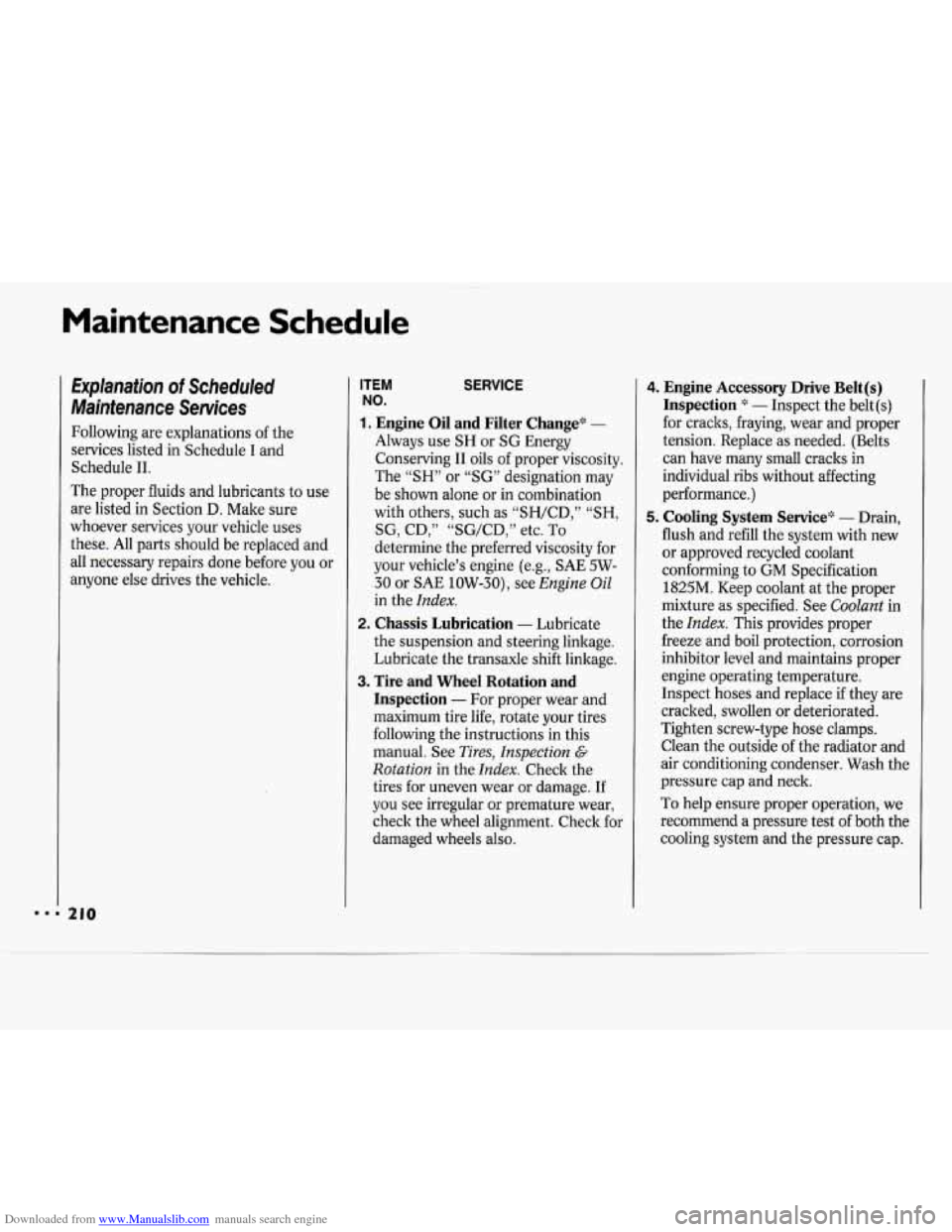
Downloaded from www.Manualslib.com manuals search engine Maintenance Schedule
Explanation of Scheduled
Maintenance Services
Following are explanations of the
services listed in Schedule
I and
Schedule 11.
The proper fluids and lubricants to use
are listed in Section
D. Make sure
whoever services your vehicle uses
these. All parts should be replaced and
all necessary repairs done before you or
anyone else drives the vehicle.
ITEM SERVICE
NO.
1. Engine Oil and Filter Change* -
Always use SH or SG Energy
Conserving I1 oils of proper viscosity.
The
“SH” or “SG” designation may
be shown alone or in combination
with others, such as “SH/CD,”
“SH,
SG, CD,” “SG/CD,” etc. To
determine the preferred viscosity for
your vehicle’s engine (e.g., SAE 5W-
30 or SAE 10W-30), see
Engine Oil
in the Index.
the suspension and steering linkage.
Lubricate the transaxle shift linkage.
Inspection - For proper wear and
maximum tire life, rotate your tires
following the instructions in this
manual. See
Tires, Inspection G
Rotation in the Index. Check the
tires for uneven wear or damage. If
you see irregular or premature wear,
check the wheel alignment. Check for
damaged wheels also.
2. Chassis Lubrication - Lubricate
3. Tire and Wheel Rotation and
4. Engine Accessory Drive Belt(s)
Inspection
* - Inspect the belt (s)
for cracks, fraying, wear and proper
tension. Replace as needed. (Belts
can have many small cracks in
individual ribs without affecting
performance.)
5. Cooling System Service* - Drain,
flush and refill the system with new
or approved recycled coolant
conforming to
GM Specification
1825M. Keep coolant at the proper
mixture as specified. See
Coolant in
the
Index. This provides proper
freeze and boil protection, corrosion
inhibitor level and maintains proper
engine operating temperature.
Inspect hoses and replace if they are
cracked, swollen or deteriorated.
Tighten screw-type hose clamps.
Clean the outside of the radiator and
air conditioning condenser. Wash the
pressure cap and neck.
To help ensure proper operation, we
recommend a pressure test
of both the
cooling system and the pressure cap.
Page 216 of 243
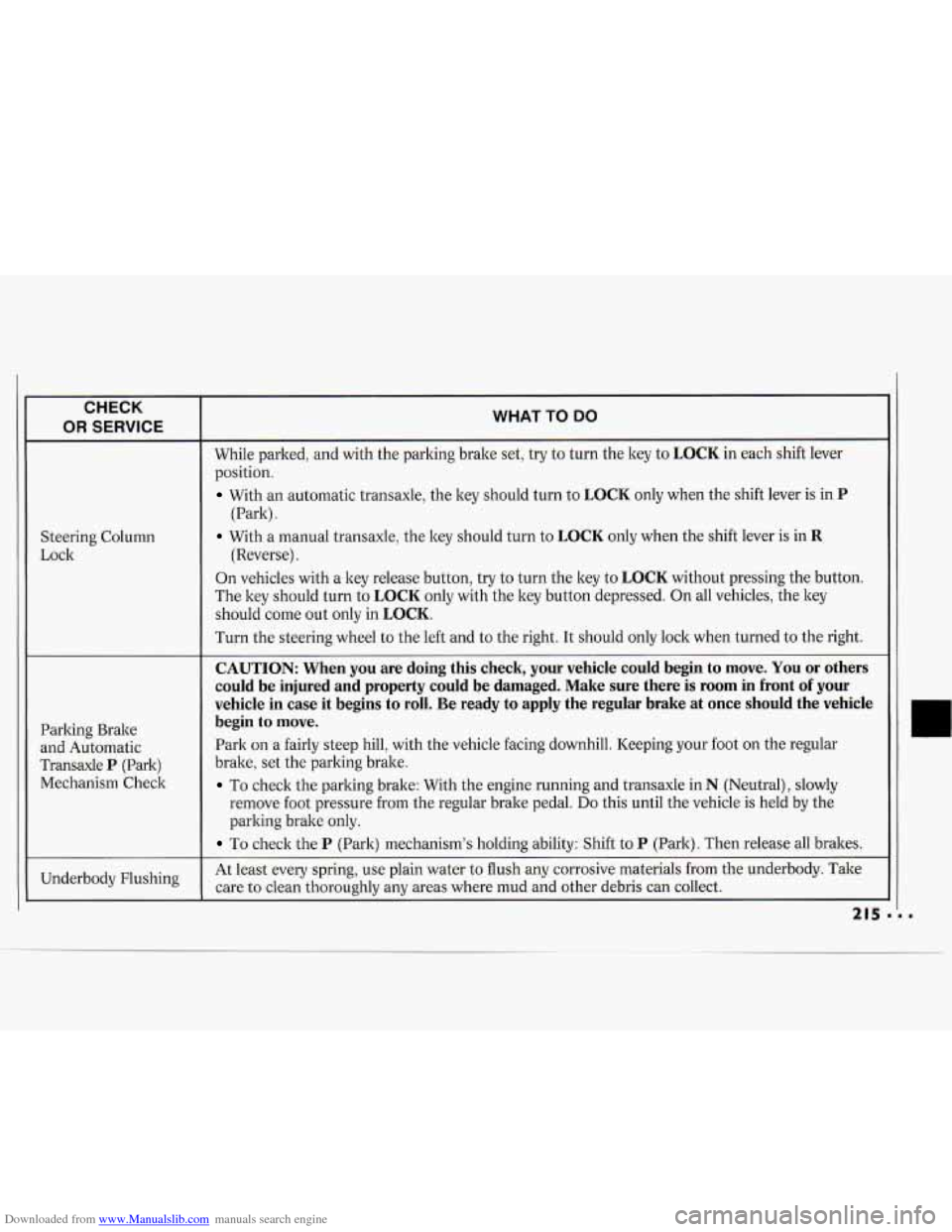
Downloaded from www.Manualslib.com manuals search engine CHECK
I OR SERVICE
Steering Column
Lock
Parking Brake
and Automatic
Transaxle
P (Park)
Mechanism Check
WHAT TO DO
While parked, and with the parking brake set, try to turn the key to LOCK in each shift lever
position.
With an automatic transaxle, the key should turn to LOCK only when the shift lever is in P
(Park) .
With a manual transaxle, the key should turn to LOCK only when the shift lever is in R
(Reverse).
On vehicles with a key release button, try to turn the key to
LOCK without pressing the button.
The key should turn to
LOCK only with the key button depressed. On all vehicles, the key
should come out only in
LOCK.
Turn the steering wheel to the left and to the right. It should only lock when turned to the right.
~~ ~~ ~
CAUTION: When you are doing this check, your vehicle could begin to move. You or others
could be injured and property could be damaged. Make sure ther\
e is room in front
of your
vehicle in case
it begins to roll. Be ready to apply the regular brake at once should the vehicle
begin to move.
Park on a fairly steep hill, with the vehicle facing downhill. Keeping your foot on the regular
brake, set the parking brake.
To check the parking brake: With the engine running and transaxle in N (Neutral), slowly
remove foot pressure from the regular brake pedal.
Do this until the vehicle is held by the
parking brake only.
To check the P (Park) mechanism’s holding ability: Shift to P (Park). Then release all brakes.
At least every spring, use plain water to flush any corrosive materials from the underbody. Take
care
to clean thoroughly any areas where mud and other debris can collect.
Page 217 of 243
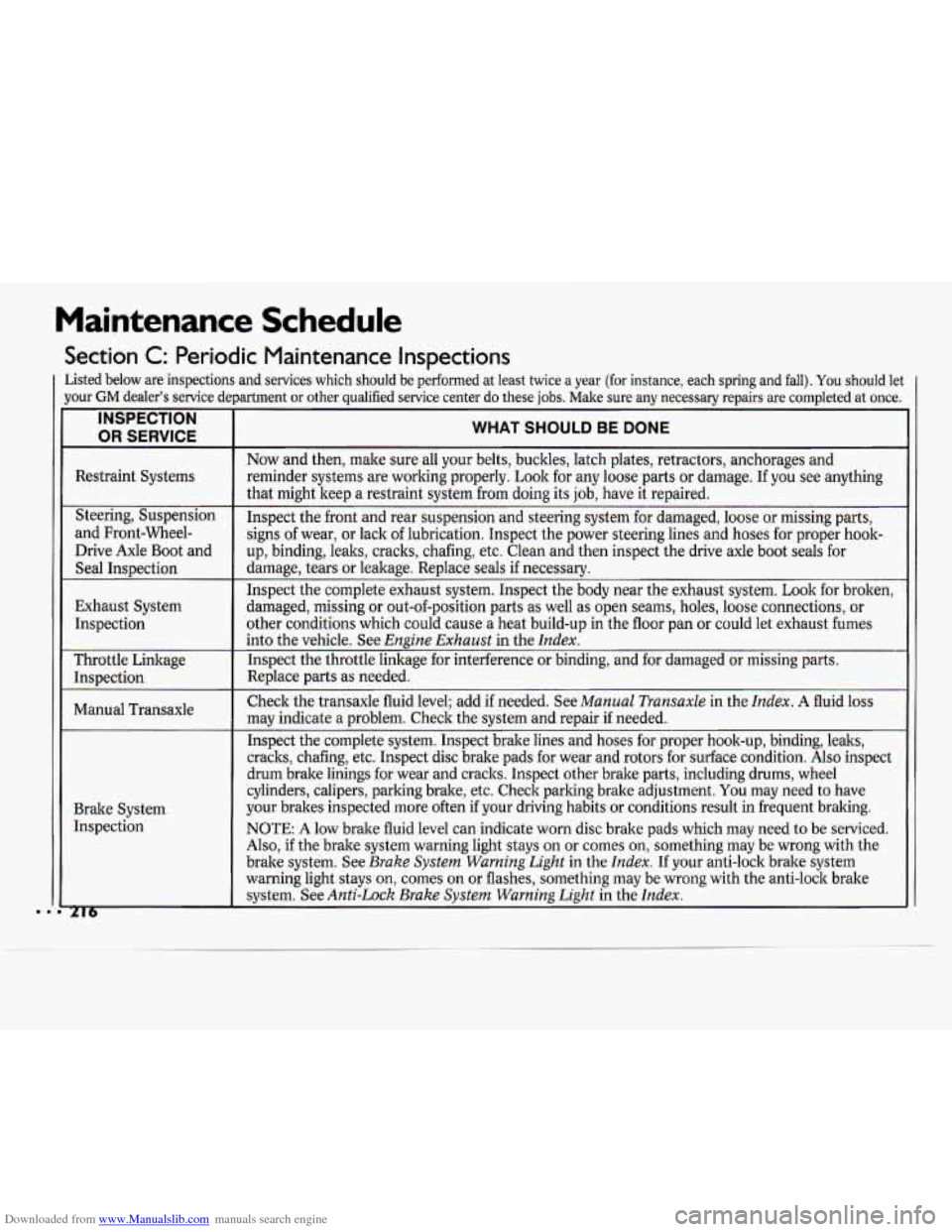
Downloaded from www.Manualslib.com manuals search engine Maintenance Schedule
Section C: Periodic Maintenance Inspections
Listed below are inspections and services which should be performed at least twice a year (for instance, each spring and fall). You should let
Jour
GM dealer’s service department or other qualified service center \
do these jobs. Make sure any necessary repairs are completed at once.
INSPECTION
OR SERVICE
Restraint Systems
Steering, Suspension
and Front-Wheel-
Drive Axle Boot and
Seal InsDection
Exhaust System Inspection
Throttle Linkage Inspection
Manual Transaxle
Brake System Inspection
216
WHAT SHOULD BE DONE
Now and then, make sure all your belts, bucltles, latch plates, retractors, anchorages and
reminder systems are worlting properly. Look for any loose parts or damage. If you see anything
that might keep a restraint system from doing its job, have it repaired.
Inspect the front and rear suspension and steering system for damaged, loose or \
missing parts,
signs of wear, or lack
of lubrication. Inspect the power steering lines and hoses for proper hook-
up, binding, leaks, cracks, chafing, etc. Clean and then inspect the drive axle boot seals for
damage, tears or leakage. Replace seals if necessary.
~ ~~~~~~
Inspect the complete exhaust system. Inspect the body near the exhaust system. Look for broken,
damaged, missing or out-of-position parts as well as open seams, holes, loose connections, or
other conditions which could cause a heat build-up in the floor pan or could let exhaust fumes
into the vehicle. See
Engine Exhaust in the Index.
Inspect the throttle linkage for interference or binding, and for damaged or missing parts.
Replace parts as needed.
.-
Check the transaxle fluid level; add if needed. See Manual Transaxle in the Index. A fluid loss
may indicate a problem. Check the system and repair if needed.
Inspect the complete system. Inspect brake lines and hoses for proper hook-\
up, binding, leaks,
cracks, chafing, etc. Inspect disc brake pads for wear and rot\
ors for surface condition. Also inspect
drum brake linings for wear and cracks. Inspect other brake parts, including drums, wheel
cylinders, calipers, parking brake, etc. Check parking brake adj\
ustment. You may need to have
your brakes inspected more often if your driving habits or conditions result in frequent braking.
NOTE: A low brake fluid level can indicate worn disc brake pads which \
may need to be serviced.
Also, if the brake system warning light stays on or comes
on, something may be wrong with the
brake system. See
Brake System Warning Light in the Index. If your anti-lock brake system
warning light stays on, comes on or flashes, something may be wrong with the anti-lock brake
system. See
Anti-Lock Brake System Warning Light in the Index.
11
.
Page 218 of 243
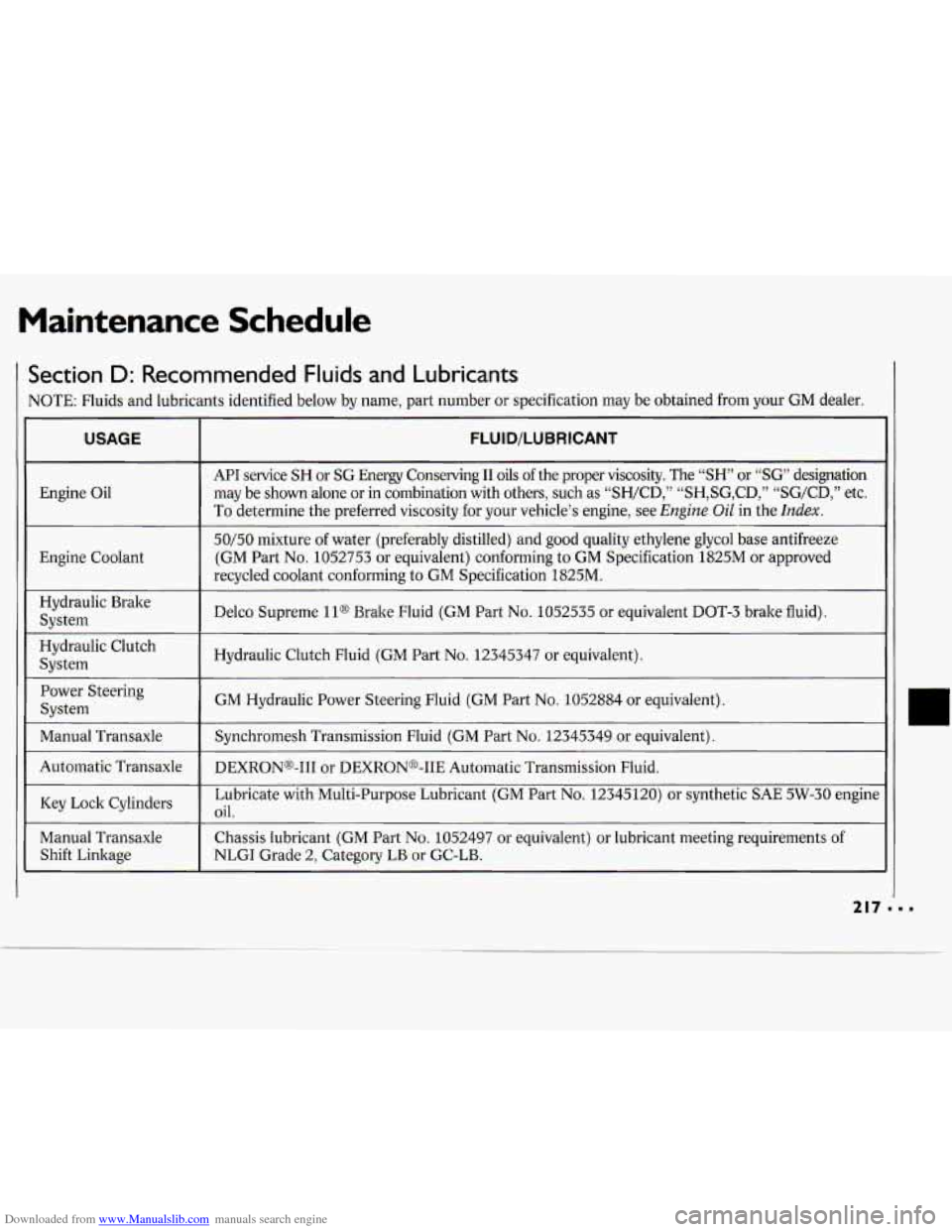
Downloaded from www.Manualslib.com manuals search engine Maintenance Schedule
Section D: Recommended Fluids and Lubricants
VOTE: Fluids and lubricants identified below by name, part number or specification may be obtained from your GM dealer. ~~ ~
USAGE
Engine Oil
Engine Coolant Hydraulic Brake
System
~~~~ ~
Hydraulic Clutch
System
Power Steering
System
Manual Transaxle
Automatic Transaxle
Key Lock Cylinders
Manual Transaxle Shift Linkage
FLUID/LUBRICANT
API service SH or SG Energy Conserving I1 oils of the proper viscosity. The “SH” or “SG” designation
may be shown alone or in combination with others, such as “SH/CD,” “SH,SG,CD,” “SG/CD,” etc.
To determine the preferred viscosity for your vehicle’s engine, see Engine Oil in the Index.
50/50 mixture of water (preferably distilled) and good quality ethylene glycol base antifreeze
(GM Part
No. 1052753 or equivalent) conforming to GM Specification 1825M or approved
recycled coolant conforming to
GM Specification 1825M.
Delco Supreme
110 Brake Fluid (GM Part No. 1052535 or equivalent DOT-3 brake fluid).
Hydraulic Clutch Fluid (GM Part No. 12345347 or equivalent).
GM Hydraulic Power Steering Fluid (GM Part
No. 1052884 or equivalent).
~ ~~~
Synchromesh Transmission Fluid (GM Part No. 12345349 or equivalent).
DEXRONo-I11 or DEXRONs-IIE Automatic Transmission Fluid.
Lubricate with Multi-Purpose Lubricant (GM Part No. 12345120) or synthetic
SAE 5W-30 engine
oil.
Chassis lubricant (GM Part No, 1052497 or equivalent) or lubricant meeting requirements of
NLGI Grade 2, Category LB or GC-LB.